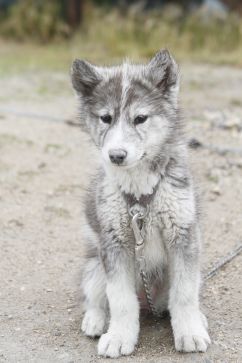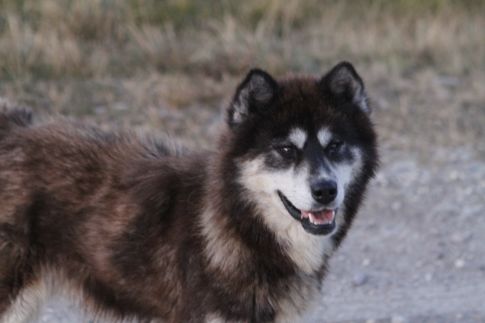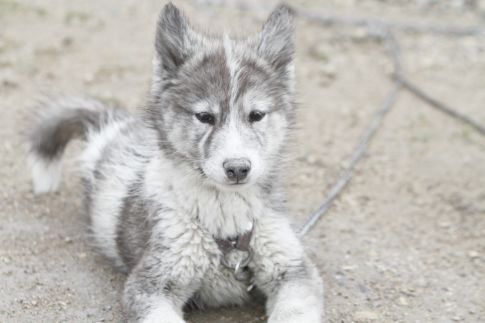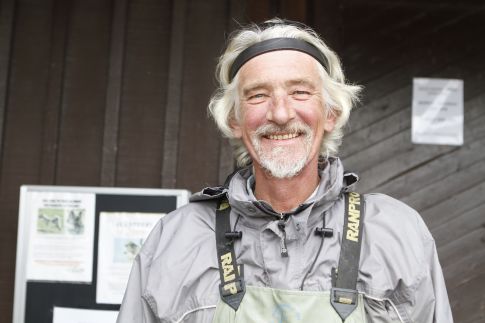 On my first afternoon in Churchill, a small town of only 700 people in the Canadian Arctic, I had already heard about the legendary Brian Ladoon. The woman asked me, “have you met Brian Ladoon yet? Have you seen Brian’s dogs yet?”
On my first afternoon in Churchill, a small town of only 700 people in the Canadian Arctic, I had already heard about the legendary Brian Ladoon. The woman asked me, “have you met Brian Ladoon yet? Have you seen Brian’s dogs yet?”
Nope, I sure had not but she was going to make sure I did. Off we went whizzing in a car where she (a local woman who worked at the hospital – let’s call her Ginny), told me story after story about Churchill, which included Brian and his Canadian Eskimo Dogs. 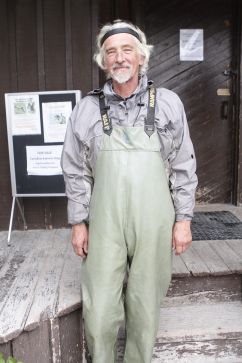
We passed his property where a number of eskimo dogs peered at us as we drove by and later that following week, I spent time with a few more who were lounging around (tied up) outside the Arctic Trading Company in the center of town.
I was across the street at the time taking in some of the local art when the store manager asked me, “have you met Brian Ladoon yet?” as I was telling her about my trip and did she have suggestions for interesting people I should talk to.
As I was about to tell her what I knew and how, she glanced out the window and eradically piped up and said, “there he is, he just went into the Arctic Trading Company and OH, his truck is parked outside.”
Off I went to meet the iconic Brian Ladoon so many locals told me about. He is the renowned quirky and fascinating man who breeds sled dogs in the midst of polar bears.
Churchill is the town in Canada most known for polar bears and the reason that people flock to the area every summer and fall, alas the very reason I was there. Each summer, the bears come ashore from Hudson Bay and wait for ice to re-form in fall so they can go out and hunt seals again. Instead of shooting bears that come near his dogs, Brian worked out a way to coexist.
He found that most of the bears simply wanted to play. So did the dogs. Whether or not it was their intent, the dominant local bears prevented any non-playful strange bears from hurting the dogs.
According to some stories, Brian’s plan worked reasonably well for over two decades until disapproving officials stepped in and removed several local bears in October 1996. In an article abridged from Outdoor Photographer Magazine in May 1997, a polar bear “ran amok through his remote sled dog camp eleven miles outside Churchill, killing 6 dogs, eating two and wounding 12 more. Actions of game wardens precipitated the attack.
Wardens knowingly thwarted Ladoon’s novel strategy that had saved countless bears and dogs. Instead of shooting bears, Ladoon allowed natural play between the bears and dogs. 
Only occasionally did he usher rare bad actors out of camp to the tune of shotgun cracks. Dominant bears accustomed to his dogs usually performed that task on their own. Before the incident, only four of his dogs had died from bear interactions in 23 seasons. None was attacked or eaten. Ladoon thought that all four prior incidents were a result of bears becoming entangled in the dogs’ chains and accidentally breaking the dogs necks in their attempts to get free.”
I didn’t have an extensive background on his life journey when I first approached him inside the trading company. “Brian Ladoon?” I asked.
It had to be him even though there were others who could have been him in the store. It was the way he was dressed. It was the rustiness of his face. It was the the man with charisma. It had to be him. He had an assured energy about him which folded into a warm, engaging smile when he greeted you. He is also a man easily distracted after seconds of a conversation.
Even though he had extra reason to be distracted that day (his truck had broken down and needed some work), I got the feeling he was always that way. He had places to go, people to see, a truck to repair? You get the idea.
So, I followed him outside and we talked on the porch for awhile, at least for as long as I could keep his attention. I figured I’d be better off joining his motley crew of friends if I were to continue learning more about his life — they were circled around the front of his truck, which was open, and there were a few men fiddling with the engine’s bits.
Then I noticed the dogs – the other eskimo dogs, that were inside town. Eskimo Dogs. BEAUTIFUL eskimo dogs. I stopped dead in my tracks as I sunk lower to the wet ground and peered inside the first dog house I saw.
They had me at hello. ALL OF THEM. 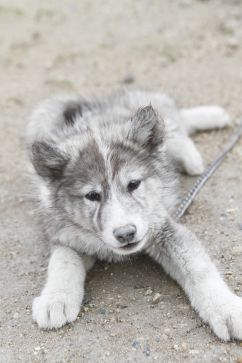
The Canadian Eskimo Dog is the oldest indigenous domestic dog species still existing in North America. This rare species is an important icon in the Inuit/Eskimo history.
As I was trying to get one of the dogs to play, I spotted a notice on the trading post door which read: VOLUNTEERS WANTED. I walked closer.
The sign read:
“Your generous donation of a few hours of labor contributes a great deal and will be proudly acknowledged on the official
Canadian Eskimo Dog Foundation Website.”
The Foundation was established to facilitate a better understanding of the Canadian Eskimo Dog, and to promote and save what is one of the last remaining strongholds for this breed.
Currently the CEDF is the largest and one of the oldest CED breeding kennels in the World, accounting for approximately one third of the World’s population. It is the CEDF’s goal to provide the World a window to view, and if desired, an opportunity to support and save the Eskimo dog from extinction.
There’s also a very interesting documentary movie called The Last Dogs of Winter that includes Brian’s story. The film was an official selection at the 2011 Toronto International Film Festival. See synopsis below.
Caleb Ross was an actor from New Zealand who pulled up stakes and relocated to Toronto, Canada when he fell in love. However, the relationship took a turn for the worst, and looking for a new adventure, Ross headed to the small Manitoba town of Churchill, where he took what he expected to be a temporary job with Brian Ladoon helping care for a rare breed of dog, the Quimmiq.
One of the very few breeds of dogs indigenous to Canada, the Quimmiq is an Eskimo dog that was used to pull dogsleds and can thrive in bitterly cold temperatures. In the 1970s, the Quimmiq was close to extinction, but Ladoon has dedicated his life to keep them alive, helping to breed the dogs and see that they’re cared for properly. Three years after he signed on to help with the dogs, Ross is still in Churchill, working full time beside Ladoon in an ongoing crusade to keep the Eskimo dogs alive. Filmmaker Costa Botes offers a look into the lives of Ross and Ladoon, their demanding daily routine, and the animals they love in the documentary The Last Dogs Of Winter.

Renee Blodgett is the founder of We Blog the World. The site combines the magic of an online culture and travel magazine with a global blog network and has contributors from every continent in the world. Having lived in 10 countries and explored nearly 80, she is an avid traveler, and a lover, observer and participant in cultural diversity.
She is also the CEO and founder of Magic Sauce Media, a new media services consultancy focused on viral marketing, social media, branding, events and PR. For over 20 years, she has helped companies from 12 countries get traction in the market. Known for her global and organic approach to product and corporate launches, Renee practices what she pitches and as an active user of social media, she helps clients navigate digital waters from around the world. Renee has been blogging for over 16 years and regularly writes on her personal blog Down the Avenue, Huffington Post, BlogHer, We Blog the World and other sites. She was ranked #12 Social Media Influencer by Forbes Magazine and is listed as a new media influencer and game changer on various sites and books on the new media revolution. In 2013, she was listed as the 6th most influential woman in social media by Forbes Magazine on a Top 20 List.
Her passion for art, storytelling and photography led to the launch of Magic Sauce Photography, which is a visual extension of her writing, the result of which has led to producing six photo books: Galapagos Islands, London, South Africa, Rome, Urbanization and Ecuador.
Renee is also the co-founder of Traveling Geeks, an initiative that brings entrepreneurs, thought leaders, bloggers, creators, curators and influencers to other countries to share and learn from peers, governments, corporations, and the general public in order to educate, share, evaluate, and promote innovative technologies.

